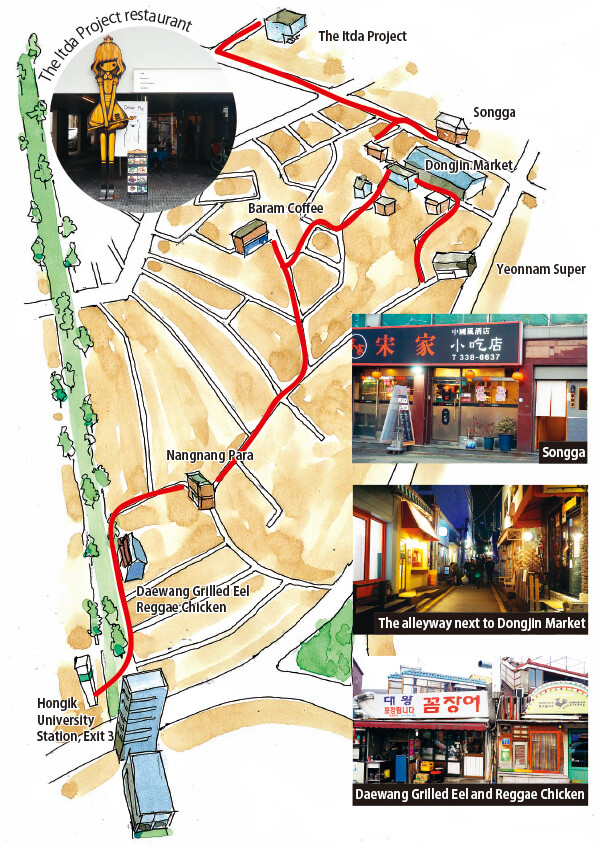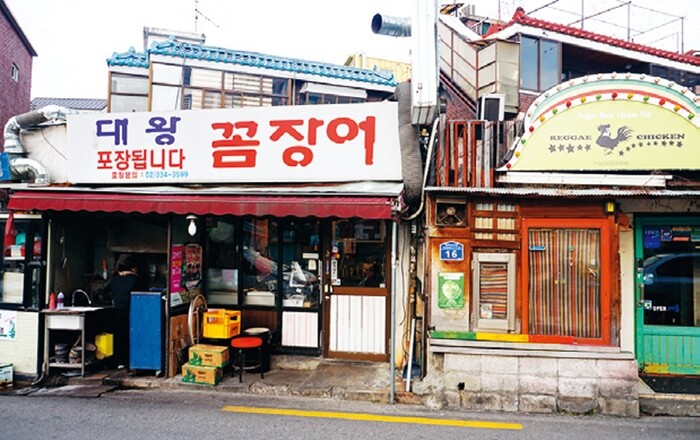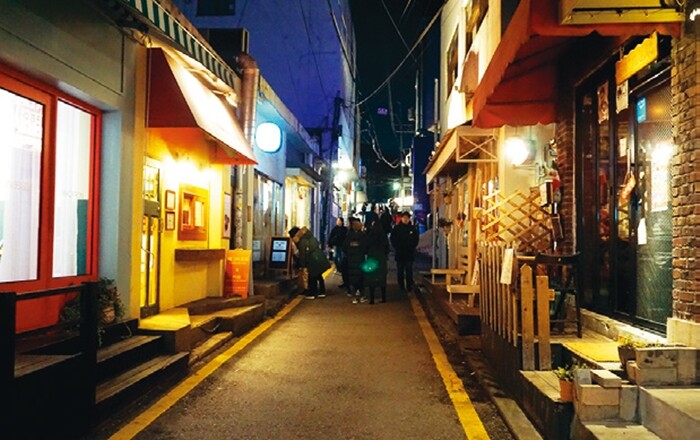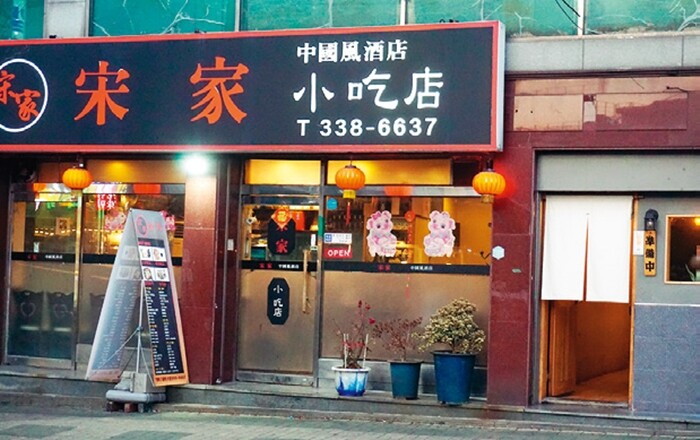hankyoreh
Links to other country sites 다른 나라 사이트 링크
[Seoul travels] The wisdom of labyrinths in Yeonnam

One day, the road suddenly disappeared in front of me. I didn’t want to believe it was real, but it was. That was the situation ushered in by the monstrous COVID-19 pandemic. Now it feels like a labyrinth, leaving us wondering which way is out.
As I was looking around my room, I spied a book: “The Labyrinth in Culture and Society” by Jacques Attali. I’d read it 20 years or so before, but what awaited me was a sentence I hadn’t noticed before.
“There is a grave risk that those who have forgotten the ancient wisdom contained in labyrinths, those who admire reason and speed and believe that they can live forever, will lose their way and wander. Conversely, those who patiently seek out the labyrinth’s secrets anew, those who follow the labyrinth’s teachings and solve its riddles, will pass safely through the forest of the future.”
I was also someone who had grown accustomed to life without the ancient wisdom of labyrinths. I had to set a clear goal and choose the quick path to achieve it; efficiency was always the paramount virtue. Losing my way and turning back meant the loss of time and money. Yet now I find myself having to listen to the way of the labyrinth, rather than the straight-line path. Today’s labyrinth lies within the old side streets of the city. Not only does Seoul’s Yeonnam neighborhood boast a veritable labyrinth of side streets, but it also has its very own “Maze Alley.”

As I head out of Exit 3 of Hongik University Station, I am immediately greeted by Gyeongui Railway Forest Road. People refer to the invigorating green strip that stretches from here to Hongje Stream as “Yeontral Park,” a playful nod to New York’s Central Park. But this place wasn’t always so lively. After the railway tracks here went underground, the area was virtually abandoned by commerce. The actual land where the tracks had been was sectioned off by makeshift steel barricades. Passersby often threw trash over the barricades, turning the land into a wasteland.
The area was revived, however, after the city removed the barricades and built a walkway lined by grass and trees. Yeonnam became one of Seoul’s most beloved and successful urban renewal projects. Meeting with Sidae Books CEO Kim Seong-sil — who built his company’s headquarters in this neighborhood 15 years ago — I asked him where he thought the appeal of Yeonnam lay.
“First of all, it’s very accessible, which makes it an attractive neighborhood for authors who want to write books,” he said. “It’s also got a lot of small but unique restaurants and bars that offer great deals, so it’s good for hanging out together after meetings. It’s also great for a nice stroll after a hard day’s work. With a wealth of printers and design houses nearby, the area offers a good publishing infrastructure. But the rent has really gone up, so it’s going to be difficult for publishers that don’t own property.”

Publishing and other forms of content involve many people working together. In that sense, Yeonnam certainly has a robust knowledge ecosystem in place. While nearby Hongik University is a neighborhood for young people, Yeonnam is home to a broad mix of ages. I decide to head into the neighborhood. A maze of side streets and alleys awaits behind the signs reading “Daewang Grilled Eel” and “Reggae Chicken” next to the former railway lines, but I decide that the least I could do as a courtesy to the neighborhood would be take a stroll along the Gyeongui Railway first.
“Bar hopping no, forest walks yes!”
As several signs around the neighborhood show, local residents aren’t too pleased about the drinking parties that go on until all hours. But from a different perspective, such gatherings show this is no staid, lifeless neighborhood, but one where the prevailing mood wriggles like one of those grilling eels. I see quite a few locals out for walks with their pets, as well as foreign tourists. “Just stopping by lol,” reads one of the signs, and that’s the kind of place this is — bright and casual.
As I walk along, I start feeling hungry. For lunch, I lead to the Itda Project, an Italian restaurant cum gallery located on Seongmisan Road. The lasagna and burrata cheese salad here are top notch. I also discover that they don’t have a corkage fee, so I’m able to enjoy the wine I brought with me.
After my meal comes the real tour of Yeonnam’s side streets. As I pass the nearby bookstore Saie, I enter Seongmisan No. 28 Road, where I find Yeonnam’s “Workshop Street.” It’s a street popular among young women, with its collection of pet cafes, variety stores, and cocktail bars.

It’s coffee time, so I head to Baram Coffee, where drinks are prepared by local artisans. As I enter Donggyo No. 38 Road, I am met by beautiful wall paintings. A famous coffee shop by the same name has been transplanted here from its location at the foothills of Mt. Halla near Jeju National University. One of its distinctive features is the “luxury coffee tour,” which allows you to choose from among several varieties of beans. Coffee isn’t just about the taste: as the venerable coffee artisan skillfully grinds the beans and extracts their flavor into one of a small number of coffee cups purchased during business trips, the entire process is something to be enjoyed with the eyes, ears, and nose as well as the taste buds. It’s the kind of place that really helps you understand why coffee shops and outstanding restaurants are becoming such crucial elements to a good neighborhood.
As I emerge, I arrive at the main side street in this neighborhood, Yeonhui No. 1 Road, where I see Little Victory, makers of the most scrumptious macarons; Nangnang Para, a cafe that takes its name from a tea room frequented by the writer Yi Sang during the Japanese occupation; and various street stalls and flea markets. At the end of the road is Yeonnam Super, which is popular as a place where customers can enjoy a beer fresh out of the refrigerator.
Finally, I arrived at Dongjin Market. Small and humble as it may look, it stands alongside the Gyeongui Railway Forest Road as one of the two main heralds of Yeonnam’s revival. On weekends, the market sells handmade items produced in the area’s workshops; inside and outside the market. The alleyway connected to the market houses local favorites like Coffee Libre, Himeji, a Japanese curry joint, and a churro shop. Behind Dongjin Market is Yeonnam’s Maze Alley, where the side streets wind together into a labyrinth. One of the big draws here is the enjoyment of using your smartphone to find your way around like a treasure hunt.
To truly enjoy Yeonnam’s side streets, you need to visit during the evening rather than daytime. As I wrap up my visit, I head to Songga, a small Chinese restaurant with an overseas Chinese chef across from Dongjin Market. This place is a specialist in xiaochi, Chinese tapas. It’s a great place to enjoy meals at a reasonable price. The five-spice pork and sautéed eggplant with pork belly are top flight.
The maze of side streets is a resilient place, home to hardier spirits than any weed. Like a message left behind in the maze by the people of old, those who patiently walk along will soon find their way back out.
By Son Kwan-seung, travel writer
Please direct comments or questions to [english@hani.co.kr]
Editorial・opinion
![[Editorial] Penalties for airing allegations against Korea’s first lady endanger free press [Editorial] Penalties for airing allegations against Korea’s first lady endanger free press](https://flexible.img.hani.co.kr/flexible/normal/500/300/imgdb/original/2024/0502/1817146398095106.jpg) [Editorial] Penalties for airing allegations against Korea’s first lady endanger free press
[Editorial] Penalties for airing allegations against Korea’s first lady endanger free press![[Editorial] Yoon must halt procurement of SM-3 interceptor missiles [Editorial] Yoon must halt procurement of SM-3 interceptor missiles](https://flexible.img.hani.co.kr/flexible/normal/500/300/imgdb/child/2024/0501/17145495551605_1717145495195344.jpg) [Editorial] Yoon must halt procurement of SM-3 interceptor missiles
[Editorial] Yoon must halt procurement of SM-3 interceptor missiles- [Guest essay] Maybe Korea’s rapid population decline is an opportunity, not a crisis
- [Column] Can Yoon steer diplomacy with Russia, China back on track?
- [Column] Season 2 of special prosecutor probe may be coming to Korea soon
- [Column] Park Geun-hye déjà vu in Yoon Suk-yeol
- [Editorial] New weight of N. Korea’s nuclear threats makes dialogue all the more urgent
- [Guest essay] The real reason Korea’s new right wants to dub Rhee a founding father
- [Column] ‘Choson’: Is it time we start referring to N. Korea in its own terms?
- [Editorial] Japan’s rewriting of history with Korea has gone too far
Most viewed articles
- 160% of young Koreans see no need to have kids after marriage
- 2Presidential office warns of veto in response to opposition passing special counsel probe act
- 3[Editorial] Penalties for airing allegations against Korea’s first lady endanger free press
- 4[Editorial] Japan’s rewriting of history with Korea has gone too far
- 5[Column] Park Geun-hye déjà vu in Yoon Suk-yeol
- 6For survivor, Jeju April 3 massacre is a living reality, not dead history
- 7[Guest essay] Maybe Korea’s rapid population decline is an opportunity, not a crisis
- 8[Special Feature Series: April 3 Jeju Uprising, Part III] US culpability for the bloodshed on Jeju I
- 9[Column] America must frankly own up to role in tragic Jeju April 3 Incident
- 10‘My mission is suppression’: Jeju blood on the hands of the US military government